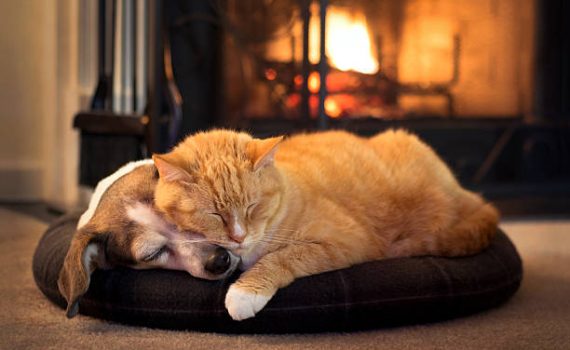
Dog & Cat Days of Summer
Yes, the lazy days of summer are upon us now. These long, languorous days when the hammock calls and the good book we promised to read falls closed as we nap away the heat-filled days with Fido snoozing at our feet and Fluffy stretched out beside us. While some of us might enjoy a few idyllic days like this, generally most of us are running out the door to work while Fido snores on the couch and Fluffy dozes in her favorite chair. The common theme here is that unlike us our pets lead a pretty sleep-filled life no matter the season.
So Much Sleep
Have you ever wondered, perhaps a little jealously, how many hours your pets sleep during the day? On average dogs spend about 12 hours sleeping; some dogs need a little more sleep, and some need less. Cats are crepuscular creatures, and many will sleep most of the day and night, becoming active during daybreak and twilight. Generally, cats will sleep 9 to 12 hours in a 24 hour period. Senior dogs and cats will sleep longer, 18 to 20 hours a day, while young puppies and kittens will also need more sleep as this is an important part of their growth cycle. But all bets are off as pups and kittens reach adolescence and become dynamos, leaving their owners wondering if the little darlings will ever slow down and rest.
Sleep Patterns
Dogs and cats both exhibit a polyphasic sleep pattern. This is an intermittent series of short sleep periods which is unlike a human’s normal single long sleep period. During our long sleeping phase, humans spend the most restful period in Rapid Eye Movement (REM) sleep. This is high-brain activity sleep and is the deepest, most refreshing sleep. REM occurs rather late in the total sleep cycle, accounting for 20 – 25% of our sleep. Cats and dogs spend the majority of their sleep time in Slow Wave Sleep (SWS) which is low brain activity and not nearly as productive sleep. Because dogs and cats do not sleep in long enough stretches to achieve much REM sleep (they typically only get 8% to 12% REM daily) they require more overall sleep to get more actual rest. Hence, they need to cat nap or spend more hours in doggie dreamland to be healthy.
Dreams
Scientists have determined that cats and dogs do dream. Dreams occur during their brief REM sleep cycles and are important for high-quality sleep. Evidently dreaming contributes to mental and emotional health in some significant way that is not yet fully understood but is universally acknowledged. No one can be sure what our pets dream about, but we conjecture that, like us, their dreams are about daily activities. Pet owners report seeing pets mimicking running, swiping, grabbing, and also growling, grimacing, and whining while asleep. It’s hard to imagine what our pets might dream about; maybe chasing prey or being chased or out-barking the neighbor’s dog or a smorgasbord of tasty treats might feature in their dreams. Who knows, they might even dream about us!
Variables to Consider
But what about all of those working dogs who spend their days at tasks and not dozing? Studies have shown that working breeds tend to sleep less but often sleep deeper and longer during their off seasons (hunting breeds) or in between their chores (guard dogs, herding dogs, etc.). Other factors that can influence amounts of sleep are activity levels, the season of the year (extra sleep during winter due to melatonin increase), size (larger dogs sleep more than smaller dogs), health conditions, and dietary or environmental changes.
As you watch your dogs or cats snoozing simply remind yourself that twelve hours out of their twenty-four will normally be spent in sweet, dreamy oblivion, and there’s nothing wrong with that. Remember as Carrie Snow, the comedian, said, “No day is so bad it can’t be fixed with a nap.”